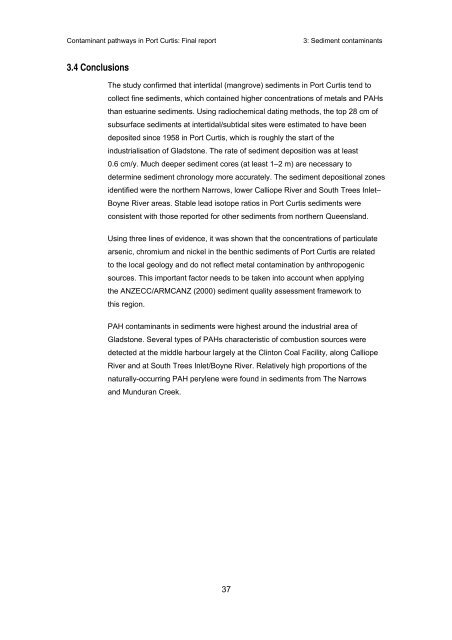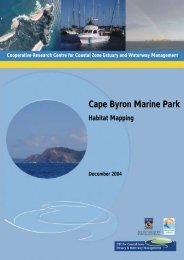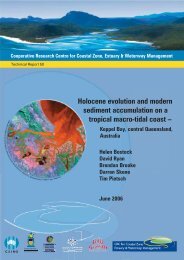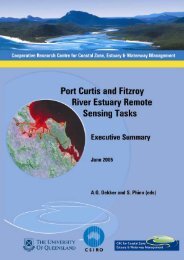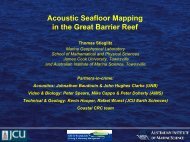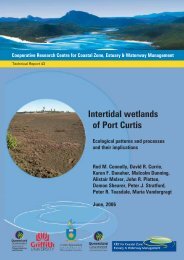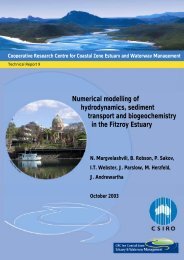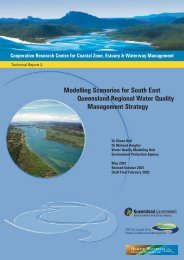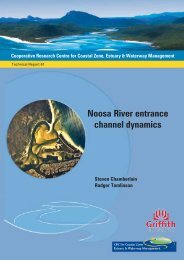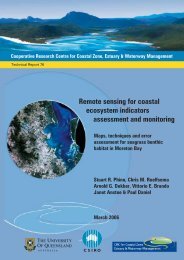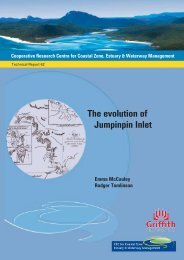Contaminant pathways in Port Curtis: Final report - OzCoasts
Contaminant pathways in Port Curtis: Final report - OzCoasts
Contaminant pathways in Port Curtis: Final report - OzCoasts
Create successful ePaper yourself
Turn your PDF publications into a flip-book with our unique Google optimized e-Paper software.
<strong>Contam<strong>in</strong>ant</strong> <strong>pathways</strong> <strong>in</strong> <strong>Port</strong> <strong>Curtis</strong>: F<strong>in</strong>al <strong>report</strong>3: Sediment contam<strong>in</strong>ants3.4 ConclusionsThe study confirmed that <strong>in</strong>tertidal (mangrove) sediments <strong>in</strong> <strong>Port</strong> <strong>Curtis</strong> tend tocollect f<strong>in</strong>e sediments, which conta<strong>in</strong>ed higher concentrations of metals and PAHsthan estuar<strong>in</strong>e sediments. Us<strong>in</strong>g radiochemical dat<strong>in</strong>g methods, the top 28 cm ofsubsurface sediments at <strong>in</strong>tertidal/subtidal sites were estimated to have beendeposited s<strong>in</strong>ce 1958 <strong>in</strong> <strong>Port</strong> <strong>Curtis</strong>, which is roughly the start of the<strong>in</strong>dustrialisation of Gladstone. The rate of sediment deposition was at least0.6 cm/y. Much deeper sediment cores (at least 1–2 m) are necessary todeterm<strong>in</strong>e sediment chronology more accurately. The sediment depositional zonesidentified were the northern Narrows, lower Calliope River and South Trees Inlet–Boyne River areas. Stable lead isotope ratios <strong>in</strong> <strong>Port</strong> <strong>Curtis</strong> sediments wereconsistent with those <strong>report</strong>ed for other sediments from northern Queensland.Us<strong>in</strong>g three l<strong>in</strong>es of evidence, it was shown that the concentrations of particulatearsenic, chromium and nickel <strong>in</strong> the benthic sediments of <strong>Port</strong> <strong>Curtis</strong> are relatedto the local geology and do not reflect metal contam<strong>in</strong>ation by anthropogenicsources. This important factor needs to be taken <strong>in</strong>to account when apply<strong>in</strong>gthe ANZECC/ARMCANZ (2000) sediment quality assessment framework tothis region.PAH contam<strong>in</strong>ants <strong>in</strong> sediments were highest around the <strong>in</strong>dustrial area ofGladstone. Several types of PAHs characteristic of combustion sources weredetected at the middle harbour largely at the Cl<strong>in</strong>ton Coal Facility, along CalliopeRiver and at South Trees Inlet/Boyne River. Relatively high proportions of thenaturally-occurr<strong>in</strong>g PAH perylene were found <strong>in</strong> sediments from The Narrowsand Munduran Creek.37


